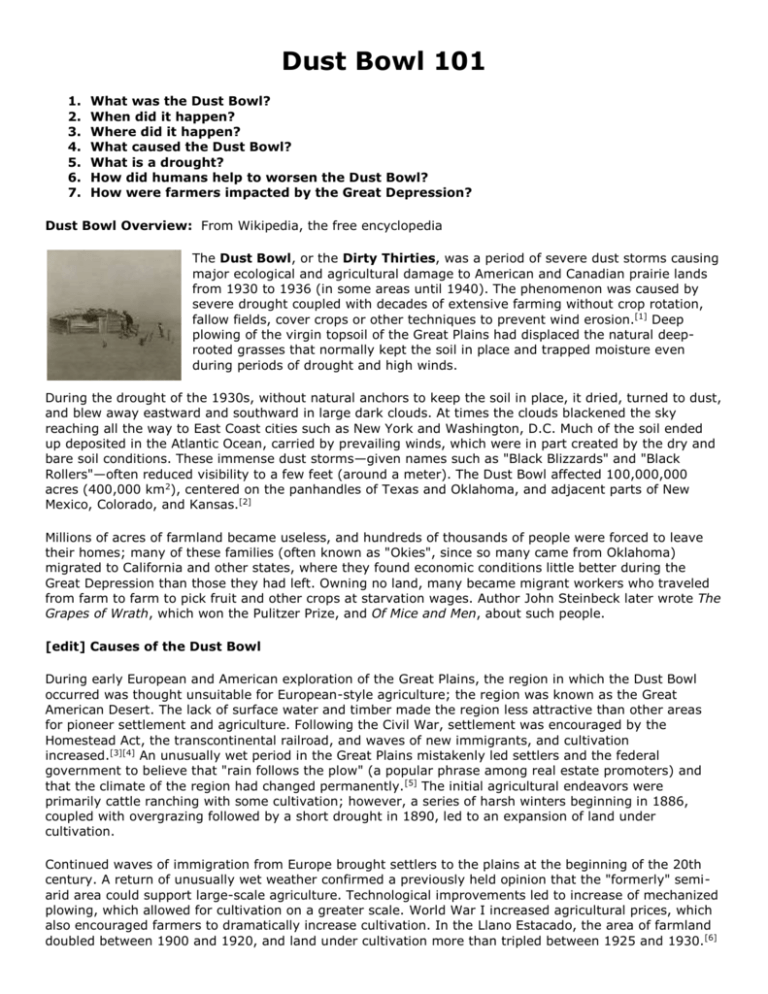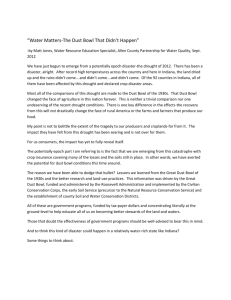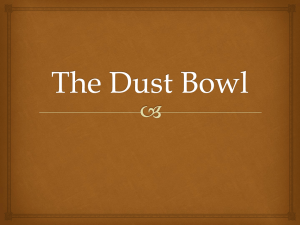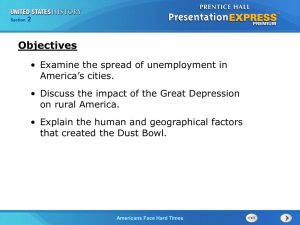Dust Bowl 101
advertisement

Dust Bowl 101 1. 2. 3. 4. 5. 6. 7. What was the Dust Bowl? When did it happen? Where did it happen? What caused the Dust Bowl? What is a drought? How did humans help to worsen the Dust Bowl? How were farmers impacted by the Great Depression? Dust Bowl Overview: From Wikipedia, the free encyclopedia The Dust Bowl, or the Dirty Thirties, was a period of severe dust storms causing major ecological and agricultural damage to American and Canadian prairie lands from 1930 to 1936 (in some areas until 1940). The phenomenon was caused by severe drought coupled with decades of extensive farming without crop rotation, fallow fields, cover crops or other techniques to prevent wind erosion.[1] Deep plowing of the virgin topsoil of the Great Plains had displaced the natural deeprooted grasses that normally kept the soil in place and trapped moisture even during periods of drought and high winds. During the drought of the 1930s, without natural anchors to keep the soil in place, it dried, turned to dust, and blew away eastward and southward in large dark clouds. At times the clouds blackened the sky reaching all the way to East Coast cities such as New York and Washington, D.C. Much of the soil ended up deposited in the Atlantic Ocean, carried by prevailing winds, which were in part created by the dry and bare soil conditions. These immense dust storms—given names such as "Black Blizzards" and "Black Rollers"—often reduced visibility to a few feet (around a meter). The Dust Bowl affected 100,000,000 acres (400,000 km2), centered on the panhandles of Texas and Oklahoma, and adjacent parts of New Mexico, Colorado, and Kansas.[2] Millions of acres of farmland became useless, and hundreds of thousands of people were forced to leave their homes; many of these families (often known as "Okies", since so many came from Oklahoma) migrated to California and other states, where they found economic conditions little better during the Great Depression than those they had left. Owning no land, many became migrant workers who traveled from farm to farm to pick fruit and other crops at starvation wages. Author John Steinbeck later wrote The Grapes of Wrath, which won the Pulitzer Prize, and Of Mice and Men, about such people. [edit] Causes of the Dust Bowl During early European and American exploration of the Great Plains, the region in which the Dust Bowl occurred was thought unsuitable for European-style agriculture; the region was known as the Great American Desert. The lack of surface water and timber made the region less attractive than other areas for pioneer settlement and agriculture. Following the Civil War, settlement was encouraged by the Homestead Act, the transcontinental railroad, and waves of new immigrants, and cultivation increased.[3][4] An unusually wet period in the Great Plains mistakenly led settlers and the federal government to believe that "rain follows the plow" (a popular phrase among real estate promoters) and that the climate of the region had changed permanently.[5] The initial agricultural endeavors were primarily cattle ranching with some cultivation; however, a series of harsh winters beginning in 1886, coupled with overgrazing followed by a short drought in 1890, led to an expansion of land under cultivation. Continued waves of immigration from Europe brought settlers to the plains at the beginning of the 20th century. A return of unusually wet weather confirmed a previously held opinion that the "formerly" semiarid area could support large-scale agriculture. Technological improvements led to increase of mechanized plowing, which allowed for cultivation on a greater scale. World War I increased agricultural prices, which also encouraged farmers to dramatically increase cultivation. In the Llano Estacado, the area of farmland doubled between 1900 and 1920, and land under cultivation more than tripled between 1925 and 1930.[6] Finally, farmers did not use appropriate practices for the environment, but agricultural methods that allowed erosion.[1] For example, cotton farmers left fields bare over winter months, when winds in the High Plains are highest, and burned the stubble (as a form of weeding prior to planting), both depriving the soil of organic nutrients and increasing exposure to erosion. The increased exposure to erosion was revealed when a severe drought struck the Great Plains in 1934. The native grasses that once covered the prairie lands for centuries, holding the soil in place and maintaining its moisture, had been eliminated by the intensively increased plowing. The drought conditions caused the topsoil to grow dry and friable, and was carried away by the wind. The dusty soil aggregated in the air, forming immense dust clouds that prevented rainfall.[citation needed] It was not until the government promoted soil conservation programs that the area slowly began to rehabilitate.[7] [edit] Drought and dust storms The unusually wet period, which encouraged increased settlement and cultivation in the Great Plains, ended in 1930. This was the year in which an extended and severe drought began which caused crops to fail, leaving the plowed fields exposed to wind erosion. The fine soil of the Great Plains was easily eroded and carried east by strong continental winds. On November 11, 1933, a very strong dust storm stripped topsoil from desiccated South Dakota farmlands in just one of a series of bad dust storms that year. Then, beginning on May 9, 1934, a strong two-day dust storm removed massive amounts of Great Plains topsoil in one of the worst such storms of the Dust Bowl. The dust clouds blew all the way to Chicago where it deposited 12 million pounds of dust.[10] Two days later, the same storm reached cities in the east, such as Buffalo, Boston, Cleveland, New York City, and Washington, D.C.[11] That winter (1934–1935), red snow fell on New England. On April 14, 1935, known as "Black Sunday", twenty of the worst "Black Blizzards" occurred throughout the Dust Bowl, causing extensive damage and turning the day to night; witnesses reported that they could not see five feet in front of them at certain points. [edit] U.S. Government response During President Franklin D. Roosevelt's first 100 days in 1933, governmental programs designed to conserve soil and restore the ecological balance of the nation were implemented. Interior Secretary Harold L. Ickes established the Soil Erosion Service in August 1933 under Hugh Hammond Bennett. In 1935 it was transferred and reorganized under the Department of Agriculture and renamed the Soil Conservation Service. More recently it has been renamed the Natural Resources Conservation Service (NRCS).[15] Additionally, the Federal Surplus Relief Corporation (FSRC) was created after more than six million pigs were slaughtered to stabilize prices. The pigs went to waste. The FSRC diverted agricultural commodities to relief organizations. Apples, beans, canned beef, flour and pork products were distributed through local relief channels. Cotton goods were later included, to clothe the needy. [16] In 1935, the federal government formed a Drought Relief Service (DRS) to coordinate relief activities. The DRS bought cattle in counties which were designated emergency areas, for $14 to $20 a head. Animals unfit for human consumption – more than 50 percent at the beginning of the program – were killed. The remaining cattle were given to the Federal Surplus Relief Corporation (FSRC) to be used in food distribution to families nationwide. Although it was difficult for farmers to give up their herds, the cattle slaughter program helped many of them avoid bankruptcy. "The government cattle buying program was a God-send to many farmers, as they could not afford to keep their cattle, and the government paid a better price than they could obtain in local markets."[17] President Roosevelt ordered the Civilian Conservation Corps to plant a huge belt of more than 200 million trees from Canada to Abilene, Texas to break the wind, hold water in the soil, and hold the soil itself in place. The administration also began to educate farmers on soil conservation and anti-erosion techniques, including crop rotation, strip farming, contour plowing, terracing, and other improved farming practices.[18][19] In 1937, the federal government began an aggressive campaign to encourage Dust Bowlers to adopt planting and plowing methods that conserved the soil. The government paid the reluctant farmers a dollar an acre to practice one of the new methods.




